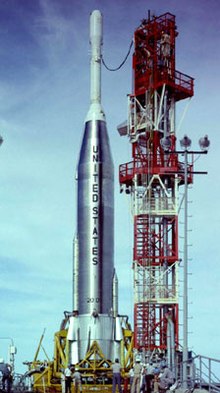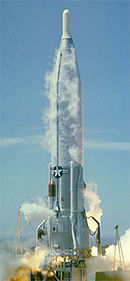
A | B | C | D | E | F | G | H | CH | I | J | K | L | M | N | O | P | Q | R | S | T | U | V | W | X | Y | Z | 0 | 1 | 2 | 3 | 4 | 5 | 6 | 7 | 8 | 9
 The Atlas-D Able rocket carrying Pioneer P-3, sitting on Cape Canaveral's Launch Complex 14. | |
| Manufacturer | Convair Division of General Dynamics |
|---|---|
| Country of origin | United States |
| Size | |
| Height | 28 m (91 ft) |
| Diameter | 3.05 m (10 ft) |
| Payload to Trans-lunar injection | 170 kg (370 lb) |
| Launch history | |
| Status | Retired |
| Launch sites | LC-12, 13 & 14, Cape Canaveral |
| Total launches | 3 |
| Failure(s) | 3 |
| First flight | 26 November 1959 |
| Last flight | 15 December 1960 |
The Atlas-Able was an American expendable launch system derived from the SM-65 Atlas missile. It was a member of the Atlas family of rockets, and was used to launch several Pioneer spacecraft towards the Moon. Of the five Atlas-Able rockets built, two failed during static firings, and the other three failed to reach orbit.[1]
The Atlas-Able was a three-and-a-half-stage rocket, with a stage-and-a-half Atlas missile as the first stage, an Able second stage, and an Altair third stage.[2]
The first Atlas-Able used an Atlas C as the first stage,[3] and was intended to carry Pioneer P-1, but exploded during a static fire test on 24 September 1959.[4]
The remaining Pioneer launches used Atlas D missiles. Launches were conducted from Launch Complexes 12 and 14 at the Cape Canaveral Air Force Station. One launch was planned from Launch Complex 13; this became the second Atlas-Able to be destroyed during a static firing, and hence never launched.[1]
Launches
| Date | Serial No. | Mission | Launch Site | Outcome | Photo | |
|---|---|---|---|---|---|---|
| - | Atlas 9C | Pioneer P-1 | LC-14 | Failure. Explosion during a static fire test. | 
| |
| 26 November 1959 | Atlas 20D | Pioneer P-3 | LC-14 | Failure. The Payload fairing broke up at 45 seconds after liftoff, causing loss of the upper stage and payload.[6] | ||
| 25 September 1960 | Atlas 80D | Pioneer P-30 | LC-12 | Failure. A propellant feed on the second stage had a malfunction.[7] | 
|
|
| 15 December 1960 | Atlas 91D | Pioneer P-31 | LC-12 | Failure. Vibration and/or debris from the Able adapter section ruptured the liquid oxygen tank of Atlas, causing an explosion.[8] |
References
- ^ a b Encyclopedia Astronautica - Atlas
- ^ a b Gunter's Space Page - Atlas-D Able
- ^ a b Gunter's Space Page - Atlas-C Able
- ^ Space Review, The Pioneer lunar orbiters: a forgotten failure, by Andrew J. LePage, Monday, December 13, 2010
- ^ "Atlas-Able". nextspaceflight.com. Retrieved 2022-02-18.
- ^ "Atlas-D Able | Pioneer P-3". nextspaceflight.com. Retrieved 2022-02-18.
- ^ "Atlas-D Able | Pioneer P-30". nextspaceflight.com. Retrieved 2022-02-18.
- ^ "Atlas-D Able | Pioneer P-31". nextspaceflight.com. Retrieved 2022-02-18.
Text je dostupný za podmienok Creative Commons Attribution/Share-Alike License 3.0 Unported; prípadne za ďalších podmienok. Podrobnejšie informácie nájdete na stránke Podmienky použitia.
Antropológia
Aplikované vedy
Bibliometria
Dejiny vedy
Encyklopédie
Filozofia vedy
Forenzné vedy
Humanitné vedy
Knižničná veda
Kryogenika
Kryptológia
Kulturológia
Literárna veda
Medzidisciplinárne oblasti
Metódy kvantitatívnej analýzy
Metavedy
Metodika
Text je dostupný za podmienok Creative
Commons Attribution/Share-Alike License 3.0 Unported; prípadne za ďalších
podmienok.
Podrobnejšie informácie nájdete na stránke Podmienky
použitia.
www.astronomia.sk | www.biologia.sk | www.botanika.sk | www.dejiny.sk | www.economy.sk | www.elektrotechnika.sk | www.estetika.sk | www.farmakologia.sk | www.filozofia.sk | Fyzika | www.futurologia.sk | www.genetika.sk | www.chemia.sk | www.lingvistika.sk | www.politologia.sk | www.psychologia.sk | www.sexuologia.sk | www.sociologia.sk | www.veda.sk I www.zoologia.sk

